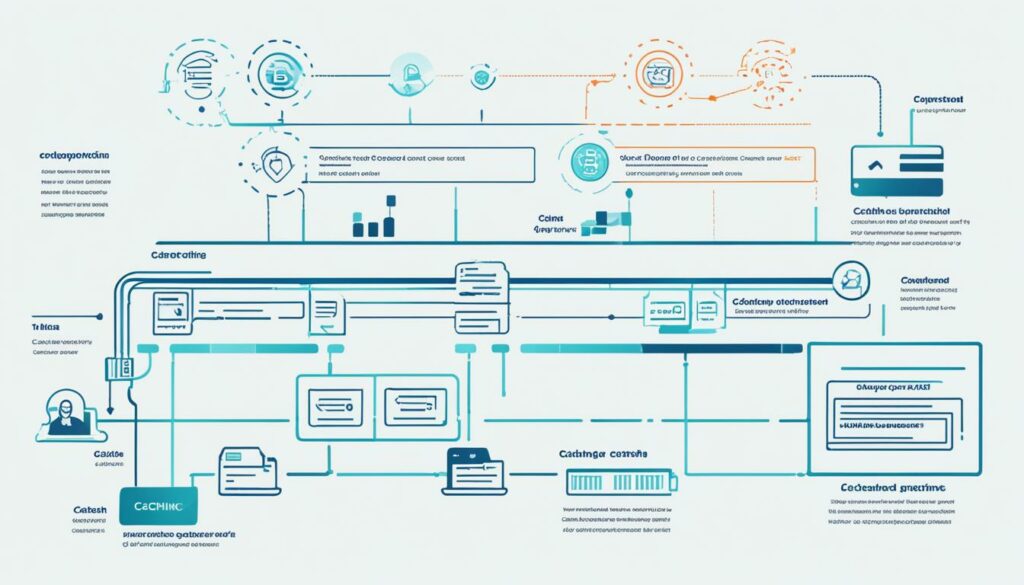Are you tired of slow loading times on your website? Do you want to improve website speed and enhance user experience? Look no further! Caching and web hosting can be the game-changer you need.
Caching is a practical and straightforward method to increase website speed and improve user experience. Slow loading times can result in traffic loss and lower SEO rankings. Website caching stores copies of the website closer to the user, reducing loading times and improving overall performance. It is an essential technology for web hosting, resulting in higher SEO rankings, customer loyalty, conversions, and revenue.
Key Takeaways:
- Caching is a powerful tool that can significantly improve website speed.
- Slow loading times can lead to traffic loss and lower SEO rankings.
- Caching stores copies of websites closer to users, reducing loading times and improving overall performance.
- Implementing caching can result in higher SEO rankings, customer loyalty, conversions, and revenue.
- Web hosting plays a crucial role in optimizing website performance through caching.
The Importance of Caching in Web Hosting
Caching plays a crucial role in web hosting, offering significant benefits for website performance and user experience. With the increasing importance of website traffic and loading times, it’s essential to understand how caching can optimize server performance and improve overall efficiency.
When a website experiences high traffic, it can put strain on the server, resulting in slower loading times and potentially negatively impacting user experience. This is where caching solutions come into play. Caching involves storing a snapshot of the website’s data in various locations, reducing the need to fetch data directly from the server for each user request.
By caching website data, the response time is significantly reduced, resulting in faster loading times and improved server performance. This allows the server to operate at peak speeds and handle increased traffic without compromising the user experience.
There are several types of caching solutions available for web hosting:
- Browser Caching: This type of caching stores web objects, such as HTML, CSS, and JS files, on the user’s browser, allowing for faster loading times upon subsequent visits.
- Server Caching: Server caching involves caching data directly on the hosting server, enhancing performance for websites with large files or dynamic processes.
- CDN Caching: Content Delivery Network (CDN) caching utilizes a network of servers located worldwide to store and serve website data based on the user’s location, further reducing latency and improving loading times.
- Caching Plugins: Many web hosting sites and content management systems provide caching plugins that streamline and enhance website efficiency.
Each caching solution has its own benefits and use cases, allowing website owners to choose the most suitable option for their specific needs.
“Caching is the key to unlocking optimal website performance, resulting in faster loading times and improved user experience. By reducing the load on the server and storing website data closer to the user, caching ensures that website traffic flows smoothly and efficiently.”
Overall, implementing caching solutions in web hosting is crucial for enhancing server performance, reducing loading times, and ultimately delivering an exceptional user experience. Next, we will delve deeper into how caching works, exploring the mechanisms behind this powerful optimization technique.
| Caching Solution | Benefits | Use Cases |
|---|---|---|
| Browser Caching | Improved loading times for returning visitors | Websites with frequent content updates |
| Server Caching | Enhanced performance for websites with large files or dynamic processes | E-commerce websites, dynamic web applications |
| CDN Caching | Reduced latency and faster loading times for global user base | Websites with international reach |
| Caching Plugins | Streamlined website efficiency and performance optimization | Websites hosted on popular CMS platforms |
How Does Caching Work?
When you access a website, your browser sends a request to the server for the website’s data. This data includes coding, content, and media. The server then sends the data back to your browser, which loads each element before displaying the website.
However, several factors can slow down this process. High traffic, large amounts of data, or a distant user location can negatively impact loading times. To address these challenges and improve website performance, caching comes into play.
Caching works by storing website data in a physically closer location to you, the visitor. This reduces the need to fetch data from the server every time you access the website, significantly improving loading times.
Imagine you’re visiting a popular e-commerce website during a busy sale period. Without caching, every user would request data from the server, causing delays due to high traffic. However, with caching, the website’s data is stored in a cache server closer to you. So, instead of fetching data from the main server every time, your browser retrieves the cached data, resulting in much faster loading times.
Benefits of Caching:
- Improved website speed: Caching reduces the time it takes for your browser to fetch and load website data, resulting in faster and more responsive websites.
- Reduced server load: By serving cached data, caching reduces the strain on the server, allowing it to handle more requests efficiently.
- Enhanced user experience: Faster loading times contribute to a better user experience, keeping visitors engaged and increasing the likelihood of conversions.
- Optimized SEO rankings: Loading times and user experience are significant factors in search engine rankings. Caching can help improve these metrics, positively impacting SEO performance.
Implementing caching on websites is crucial for delivering a seamless user experience and optimizing website performance. By reducing loading times and improving server efficiency, caching plays a vital role in enhancing the overall web browsing experience.
To get a clearer understanding of how caching works, take a look at the simplified illustration below:
| Your Browser | Caching Server | Website Server |
|---|---|---|

|
Different Types of Caching
When it comes to implementing caching on your website, you have several options to choose from. Each type of caching serves a specific purpose and caters to different website requirements. Let’s explore the different types of caching and how they can enhance your website’s performance:
1. Browser Caching:
Browser caching involves storing web objects such as HTML, CSS, and JavaScript files on the user’s browser. When a visitor returns to your website, their browser can retrieve these cached files instead of fetching them from the server again. This significantly reduces the loading time and enhances the overall browsing experience for your users.
2. Server Caching:
Server caching works by storing data on the hosting server itself. This type of caching is especially beneficial for websites with large files or dynamic processes that require frequent database queries. By caching data on the server, you can minimize the processing time and optimize the server’s performance, resulting in faster loading times for your website visitors.
3. CDN Caching:
CDN caching, or Content Delivery Network caching, utilizes a network of servers located worldwide to store and serve website data based on the user’s location. This global network of servers ensures that your website’s content is cached closer to your users, reducing latency and providing faster access to your website’s resources. CDN caching is particularly useful for websites with an international audience, improving loading times for users across different geographic regions.
4. Caching Plugins:
Caching plugins are available on most web hosting sites and content management systems, such as WordPress. These plugins streamline and enhance website efficiency by automating caching processes. Caching plugins often provide additional features and customization options, allowing you to optimize caching settings based on your specific website requirements. When used correctly, caching plugins can significantly improve your website’s performance and loading times.
By employing a combination of browser caching, server caching, CDN caching, and caching plugins, you can create a robust caching strategy that maximizes your website’s speed and performance. The right caching approach will not only improve the user experience but also contribute to higher SEO rankings and increased customer satisfaction.
Next, let’s delve into effective strategies for implementing caching on your website and optimizing its performance.
Strategies to Implement Caching
Implementing caching on your website is crucial for improving performance and reducing loading times. There are different approaches you can take to implement caching effectively.
1. Web Hosting Vendors
Many web hosting vendors offer caching options as part of their hosting packages. They provide caching solutions that are optimized for their servers, ensuring seamless integration and enhanced performance. This option is suitable if you’re looking for a convenient and hassle-free caching implementation.
2. Content Delivery Network (CDN)
A Content Delivery Network, or CDN, is another caching solution that can significantly improve your website’s loading times. CDNs store a cached copy of your website on multiple servers located worldwide. When a user requests your website, the CDN serves the content from the server that is closest geographically to them. This reduces the distance that data has to travel, improving loading times for users far away from your website’s server.
3. Cloud Hosting
Cloud hosting, powered by multiple servers, is another option that benefits from caching implementation. With cloud hosting, your website is not hosted on a single server but distributed across a network of servers. Caching helps boost performance by reducing the impact of a slow internet connection and improving overall website speed and responsiveness.
When choosing a caching solution, consider your specific website needs and requirements. Evaluate factors such as server capacity, user location, and the level of control you want over your caching implementation. By selecting the right caching strategy, you can ensure optimal website performance and a seamless user experience.

| Caching Solution | Benefits |
|---|---|
| Web Hosting Vendors | – Convenient and hassle-free – Optimized for hosting servers |
| Content Delivery Network (CDN) | – Improved loading times for users worldwide – Efficient data distribution |
| Cloud Hosting | – Boosted performance and responsiveness – Mitigated impact of slow internet connection |
Solving Caching Problems in Web Applications
Caching can sometimes create issues in web applications, such as displaying outdated content to users. However, there are several strategies that developers can employ to solve these caching problems and ensure that users see the most up-to-date content.
Asset Versioning
One effective technique is asset versioning, which involves forcing browsers to fetch updated assets by using versioned URLs. By appending a unique version number to the URL of each asset, developers can ensure that users always receive the latest version of the asset, bypassing any cached versions.
Cache-Control Headers
Another solution is configuring cache-control headers on the server. These headers allow developers to manage asset caching and specify the appropriate cache durations for different environments, such as development and production. By setting shorter cache durations for development, developers can ensure that changes and updates are immediately reflected in the application.
Service Workers
Service workers are a powerful tool for caching and improving web application performance. They run in the background and can intercept network requests, allowing developers to cache specific resources or entire pages for offline access. Service workers provide fine-grained control over caching and can help ensure that users always have access to the latest content, even when offline.
Cache-Busting Techniques
Cache-busting techniques are useful for overriding cached versions of resources. One common approach is to append a query parameter with a unique value to the URL of the resource. This tricks the browser into thinking it’s a new resource and prompts it to fetch the latest version from the server.
Content Delivery Networks and Deployment Strategies
Content delivery networks (CDNs) can also help mitigate caching issues by distributing cached copies of the website across multiple servers worldwide. This ensures that users receive the closest cached copy, minimizing the impact of caching on loading times. Additionally, using deployment strategies that allow for quick updates and replacements of cached assets can help maintain the freshness of content in web applications.
Implementing these caching solutions and employing various caching techniques can help you overcome caching issues in web applications, ensuring that users always see the latest content. By properly managing caching, you can improve the performance and user experience of your web applications.

Conclusion
In today’s fast-paced digital world, where web application performance and user experience are paramount, caching solutions have emerged as a vital tool for web hosting and development. By implementing effective caching strategies, you can significantly enhance your website’s performance, reduce loading times, and provide seamless user experiences.
There are various caching options to consider, depending on your specific requirements. Browser caching allows you to store web objects like HTML, CSS, and JS files directly on users’ browsers, ensuring quick and efficient page loading. Server caching, on the other hand, improves overall performance by storing frequently accessed data on the hosting server itself, reducing the load on the server and enhancing response times.
For websites with a global reach, CDN caching provides a practical solution. By utilizing a network of distributed servers located worldwide, CDN caching ensures that your website’s data is stored closer to the user, regardless of their location. This results in faster loading times and a seamless user experience, no matter where your visitors are located.
To overcome potential caching issues, developers can employ cache-busting techniques and deploy effective caching control strategies. These measures help ensure that users always receive the latest version of your website’s content, eliminating any potential confusion or frustration caused by outdated information.
Remember, when it comes to caching solutions, there is no one-size-fits-all approach. It’s important to analyze your specific needs and choose the caching methods that align with your goals. By prioritizing web application performance, user experience, and testing caching strategies in a development environment, you can optimize your website’s performance and provide an exceptional online journey for your users.
FAQ
Q: What is caching in web hosting?
A: Caching in web hosting is a method that stores copies of a website closer to the user, reducing loading times and improving overall performance.
Q: Why is caching important in web hosting?
A: Caching is important in web hosting because it reduces the load on the server, improves website performance, and leads to higher SEO rankings, customer loyalty, conversions, and revenue.
Q: How does caching work?
A: When a visitor accesses a website, their browser sends a request to the server for the website’s data. Caching stores website data in a physically closer location to the visitor, reducing the need to fetch data from the server and significantly improving loading times.
Q: What are the different types of caching?
A: The different types of caching include browser caching, server caching, CDN caching, and caching plugins.
Q: How can caching be implemented on a website?
A: Caching can be implemented on a website through web hosting vendors that offer caching options, Content Delivery Networks (CDNs) that store a cached copy of the website, and cloud hosting that utilizes caching to boost performance.
Q: How can caching problems in web applications be solved?
A: Caching problems in web applications can be solved by employing strategies such as asset versioning, configuring cache-control headers, using service workers, and employing cache-busting techniques.
Q: Why is caching important for web application performance and user experience?
A: Caching is important for web application performance and user experience because it significantly improves website performance, reduces loading times, and enhances the overall user experience.












